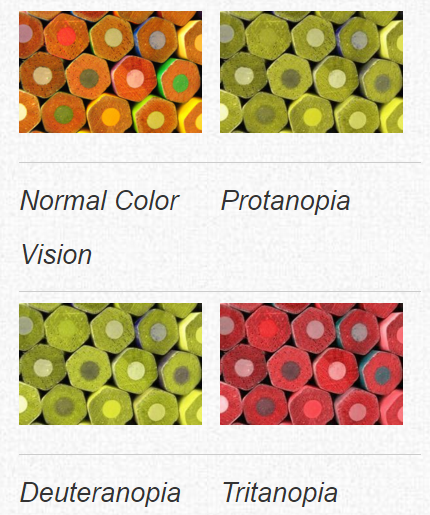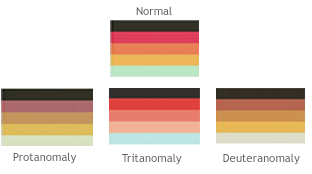Color Vision Deficiency (CVD) or color blindness, is the inability to see differences between certain colors. CVD happens when the retina's cone cells lack a color-sensitive pigment. The retina is the nerve layer located at the back of the eye. Approximately one in twelve men are color blind, while only one in 200 women are affected. People who are color-blind see colors differently than those who are not.
What Do Colorblind People See?
There are several different types of color-blindness. Learn what colorblind people see according to the types.
1. Dichromacy
Dichromacy is a condition in which the retina's cone cells are missing one of the three primary colors. Protanopia occurs when the red population is missing. Deuteranopia is when the green is missing. When the blue is missing, it's called tritanopia.
- Protanopia
 Protanopes are people with protanopia. One to five percent of men are affected, but only one tenth of one percent of women. They have trouble distinguishing black from many shades of red. They may confuse dark brown with dark orange, dark green, or dark red. They get some blues mixed up with some reds, dark pinks, and purples. They also confuse mid-greens with some oranges.
Protanopes are people with protanopia. One to five percent of men are affected, but only one tenth of one percent of women. They have trouble distinguishing black from many shades of red. They may confuse dark brown with dark orange, dark green, or dark red. They get some blues mixed up with some reds, dark pinks, and purples. They also confuse mid-greens with some oranges.
- Deuteranopia
Deuteranopes have trouble telling mid-reds from mid-greens; bright greens from yellows; pale pinks with light grey, and blue-greens from mid-pinks and grey. Statistics are similar to those with protanopia.
- Tritanopia
The rarest form of CVD is tritanopia, which affects only 0.003 percent of people. They confuse dark purples with black, mid-greens with blues, light blues with grays, and oranges with reds.
2. Anomalous Trichromacy
Most people who are color-blind have anomalous trichromacy. They can see colors in each of the three ranges because their eyes contain the three types of cone cells. However, the three cones are used in differing proportions from the person with normal vision. So find out what colorblind people see when they can't discriminate between colors that are similar, or see varying shades of a color.

- Protanomaly
Approximately one percent of men have a condition known as protanomaly, an X-linked disorder. The red cone photopigment is abnormal, causing red, orange, and yellow to look greener. Colors do not appear as bright. This condition is relatively negligible and seldom affects the daily life.
- Deuteranomaly
An abnormality in the green cone causes deuteranomaly. This is the most common form of CVD and affects about five percent of men. To these people, green and yellow appear redder, and they have difficulty telling violet and blue apart.
- Tritanomaly
Tritanomaly limits the blue cone cells, making blue appear greener, and making the differences between red, pink, and yellow difficult to distinguish. Men and women are affected equally with tritanomaly.
3. Achromatopsia
 Extreme colorblindness is known as acromatopsia, and is the inherited inability to see any color. The total absence of any cone cells, or severe defects in those present limits the person to seeing everything in shades of black, gray, and white. Achromatopsia affects about one in 33,000 in the US.
Extreme colorblindness is known as acromatopsia, and is the inherited inability to see any color. The total absence of any cone cells, or severe defects in those present limits the person to seeing everything in shades of black, gray, and white. Achromatopsia affects about one in 33,000 in the US.
To learn more about what colorblind people see, click on the link and watch this video:
Why Are People Colorblind?
The normal eye has three types of cone cells, which sense red, green, or blue light waves. A person perceives color when all three of these cone cells work correctly, sensing differing amounts of the three primary colors. Those with inherited colorblindness are missing one of the types of cone cells, or they aren't functioning properly. You may not see one of the three colors, or you may see it differently. This type of CVD will not change with time.
The macula contains the highest concentration of these cone cells. People who develop macular degeneration may become colorblind to a certain degree. Other non-genetic issues that can cause colorblindness include aging, side effects from certain medications, and an eye injury. Eye diseases such as glaucoma, cataracts, or diabetic retinopathy may also cause loss of color perception.
Can Colorblindness Be Cured?
Colorblindness that is inherited cannot be corrected. No treatment is needed for the most common red-green color deficiency, because that individual can function normally. You may not even realize you don't see colors the way others do.
Depending on the cause, some color vision issues can be treated. Cataract surgery to remove cataracts may restore lost normal color vision. Eliminating problem medications may allow your color vision to revert to normal. There are a few ways to compensate for colorblindness.
- Colored contact lenses may help some to differentiate between colors. But these contacts don't give normal color vision and may distort things.
- Wear glare-blocking glasses. When there is less brightness and glare, people with severe color issues can distinguish between colors easier.
- Educate yourself on other ways to recognize important colors. A traffic signal light has the red, yellow, and green in the same spot all the time, so you can go by position rather than color.
Famous People Who Are/Were Colorblind

1. Paul Newman was a Navy pilot when he discovered he was colorblind. This condition didn't affect his career as a pilot, radioman, gunner, or actor.
2. Matt Lauer, who made Vanity Fair's top list as one of the best-dressed men, is mildly colorblind.
3. Prince William Windsor is colorblind. He wanted to undergo laser treatment to keep from wearing glasses, but ended up with glasses instead of the treatment.
4. Fred Rogers of Mr. Rogers' Neighborhood was red-green colorblind. He couldn't tell pea soup from tomato soup without tasting it. He would ask someone what kind of soup it was, because he liked a little sugar in his tomato soup.
5. Emerson Moser was a wonderful example of someone who didn't let a little colorblindness affect his job. At the time of his retirement, he had molded over 1.4 billion crayons, yet had blue-green colorblindness. No one in the plant knew his secret until he retired. This should inspire anyone with CVD that it doesn't matter what colorblind people see, if you know how to manage your condition, you can be successful.
